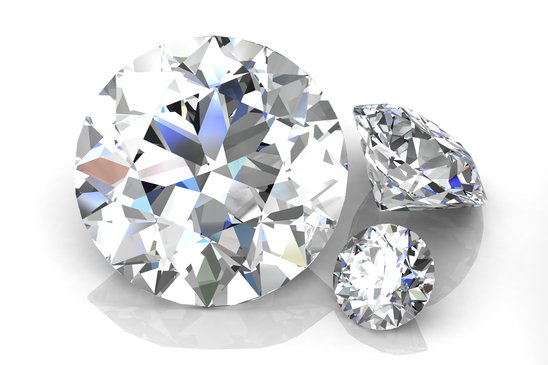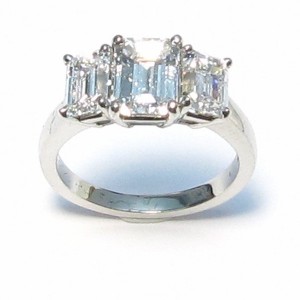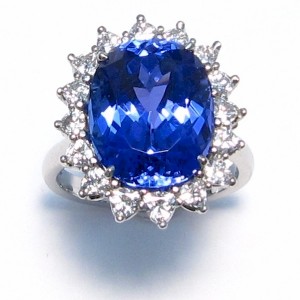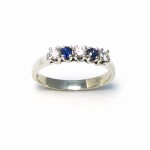The 4 C’s of Diamonds
The 4 C’s

CLARITY:
A flawless diamond with little to no imperfections is very rare and thus, can be quite costly. Is very common for diamonds to be formed with slight imperfections.
These imperfections are known as “inclusions” and usually occur during the diamond’s crystallization period within the earth, or form the stresses of mining and processing. Inclusions are anything from tiny white points to dark dots, cracks or scratches. The fewer inclusions, the more valuable the stone is.
The diamond grader examines the clarity characteristics with respect to the nature and number of characteristics, as well as their size, colour and position. The clarity grade assigned reflects the degree of visibility of the characteristics.
Clarity’s effect on value is based on rarity. The fewer and less significant the characteristics, the higher the clarity grade will be making it more rare and more expensive.
For the most part, diamonds used in Jewellery are clean to the naked eye; therefore a choice in clarity is based on personal preference. Choose the diamond you find to be the most beautiful.
COLOUR:
Choosing the right colour for your diamond is based on personal preference. It’s important to remember that you are generally searching for a stone with little to no colour.
Diamonds are coloured when the crystals grow inside the earth. Tiny traces of some elements like nitrogen can colour the crystals. In addition, the pressure involved in the diamond formation creates distortion in the crystal structure which is believed to also contribute to its colour.
Diamonds occur in a wide range of colours. The normal market range is colourless to light yellow, brown or grey. Diamonds with natural colours outside this “normal” range are classified as fancy colours.
Fancy colours include bright yellow, pink, champagne, blue and green. Colours like red, purple and orange are extremely rare.
Colour is graded most frequently using the GIA Colour Grade Scale which consists or 23 letter grades ranging from D (Colourless) to Z (Heavily Tinted). “Fancy” diamonds are grade Z+.
· D grade is absolutely colourless.
· E and F are essentially colourless. The difference between D, E and F is so slight that only experts can see it when the diamonds are unmounted.
· Grades G through J are near colourless, very faintly tinted.
· K, L, and M are faintly tinted. Diamonds under .50 carat appear colourless when mounted. Diamonds over .50 carat may show a tint of colour.
· Grades N through Z have a light tint, and it is visible.
Diamonds with fewer colours are more rare and valuable. Only about 5,000 of the polished diamonds produced each year weighing .50 carat or more are colourless. Most of the diamonds sold are grades G to L. For fancy diamonds, the value goes up with the intensity of the colour.
How the diamond is set can make a difference in colour too. Colour is more important in rings than earrings and pendants because the diamond is usually larger. Here are some tips.
· Putting a truly colourless diamond in a yellow gold setting will refect on the stone causing a yellowish tint
· Colourless and near-colourless diamonds come alive in a platinum or white gold setting.
· A slightly yellow-tinted diamond will appear whiter in a yellow gold setting.
Keep in mind that colour is only one of the 4Cs so even when a stone has a visible tint, it can still be very lovely when mixes with good clarity and cut.
CARAT:
Carat weight is an obvious feature and is the easiest to understand of the 4CS. A diamond’s weight is measured in carats. The carat is subdivided into 100 equal parts called points. One point is equal s .01 carat. 100 points adds up to one carat.
As the carat measurement increases the diameter of the stone increases, as does the price and value. Expect to pay premium for stones that above a full carat in weight. For example; a 1 (carat) stone is rarer and will cost significantly more than two .50 ct stones combined.
Diamond Size Chart In Millimeters
CUT:
When one discusses diamond cuts there are two factors to consider: One is the diamond shape and the other, refers to the quality of the diamond. Diamond proportions, symmetry and polish determine quality.
Round brilliant is considered to be one of the most popular diamond cut shapes. Other cut shapes include emerald, oval, pear, heart, princess and marquise.
A diamond’s cut ultimately determines how light is reflected (brilliance) and dispersed through it. Two diamonds equal in carat weight may have different cut qualities as a result of diamond cutting skills.
The three factors that determine a diamond’s cut quality:
- Proportions – the relative sizes and angles of the diamond
- Symmetry – the precision of the cut design
- Polish – the smoothness and luster of the diamond’s surface
.
Diamond cut grades are referenced on a diamond’s certificate using GIA standards of Excellent. Very Good, Good, Fair and Poor.






